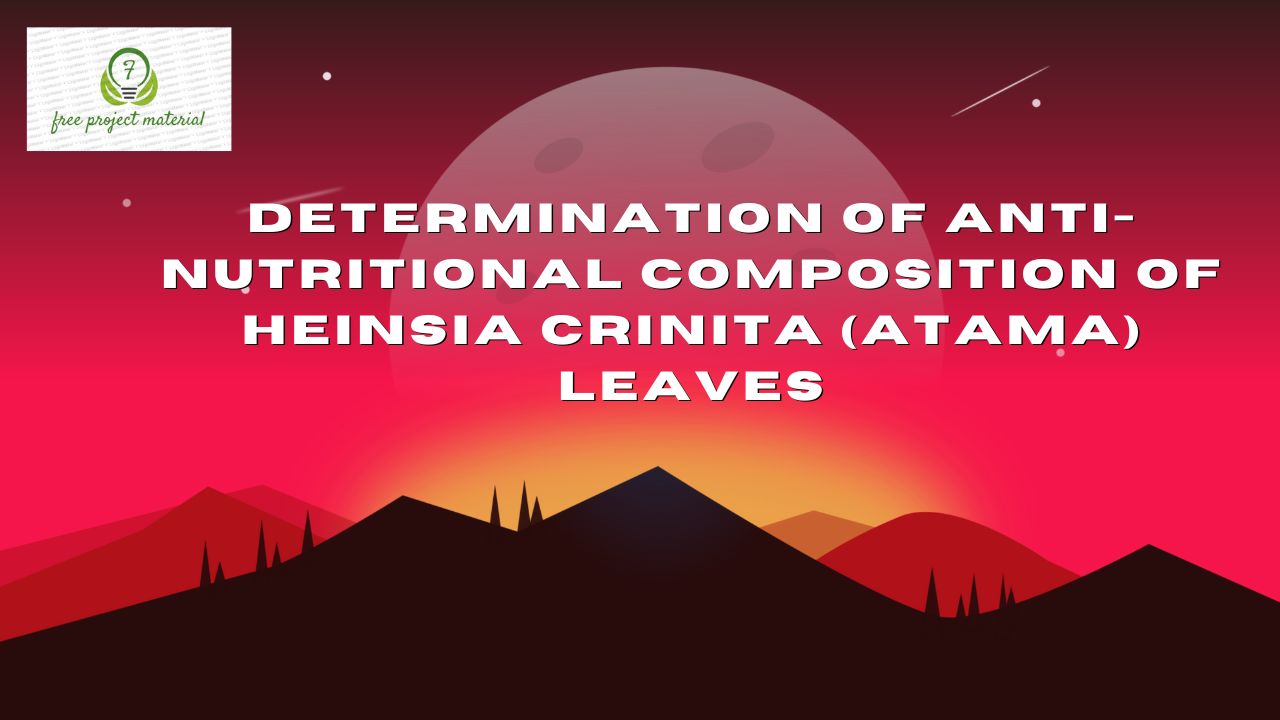ABSTRACT
The aim of this study was to determine the anti-nutritional factors of Heinsia crinita leaves. The sample was analyzed using standard analytical methods. The result of the study revealed the following; HCN (1.240±0.071 mg/100g), Tannin (07.125±0.078 mg/100g), Phytate (3.590±0.042 mg/100g) and oxalate (0.095±0.049 mg/100g). All the anti-nutrients detected were below the lethal dose. This implies that the consumption of the Heinsia crinita will not result in any toxicities from to antinutrients. Therefore, its consumption is recommended as a result of it important medicinal benefits.
TABLE OF CONTENTS
Title Page – – – – – – – – i
Certification – – – – – – – – ii
Dedication – – – – – – – – iii
Acknowledgements – – – – – – iv
Abstract – – – – – – – – vi
Table of Contents – – – – – – – vii
CHAPTER ONE: INTRODUCTION
1.1 Background of the Study – – – – – – 1
1.2 Aim and Objectives of the Study – – – – 4
1.3 Scope and Limitation of the Study – – – – 4
CHAPTER TWO: LITERATURE REVIEW
2.1 Botanical Classification of Heinsia crinita – – – 5
2.2 Description of the Plant – – – – – – 6
2.3 Uses of the Plant – – – – – – – 6
2.4 Antinutritional Factors – – – – – – 7
2.4.1 Lectins – – – – – – – – 7
2.4.2 Protease Inhibitors – – – – – – – 9
2.4.3 Phytates – – – – – – – – 9
2.4.4 Goitrogens – – – – – – – – 10
2.4.5 Oxalates – – – – – – – – 11
2.5 Antinutritional and Human Health – – – – 12
2.6 Disabling Antinutrients – – – – – – 14
CHAPTER THREE: MATERIALS AND METHOD
3.1 Materials – – – – – – – – 19
3.2 Method – – – – – – – – 19
3.2.1 Sample Collection and Preparation – – – – 19
3.2.2 Sample Digestion – – – – – – – 19
3.2.3 Determination of Anti-nutrient in the Sample – – 20
CHAPTER FOUR: RESULTS AND DISCUSSION
4.1 Results – – – – – – – – 23
4.2 Discussion – – – – – – – – 24
CHAPTER FIVE: CONCLUSION AND RECOMMENDATIONS
5.1 Conclusion – – – – – – – – 28
5.2 Recommendations – – – – – – – 28
References
CHAPTER ONE: INTRODUCTION
1.1 Background of the Study
Food is an essential part of people’s lives. Despite the world produces enough food for everyone, over 800 million people still go to bed hungry. Furthermore, malnutrition and hunger-related diseases cause over 60% of deaths. Eliminating hunger and malnutrition is one of the most fundamental challenges facing humanity. Moreover, food sufficiency is not the last aspect of importance; food nutritional quality is of critical demand as well as the effects of the accepted food portion, in particular. From this point of view, the topic of the present review antinutrients raises essential questions about human health and contributes to the understanding of what people actually eat and what the possible resulting effects can be (Ekpo et al., 2012).
Antinutritional factors are primarily associated with compounds or substances of natural or synthetic origin, which interfere with the absorption of nutrients, and act to reduce nutrient intake, digestion, and utilization and may produce other adverse effects. Antinutrients are frequently related to plant-based, raw or vegan diets and are naturally synthesized in plants. Some of the common symptoms exhibited by a large number of antinutrients in the body can be nausea, bloating, headaches, rashes, nutritional deficiencies, etc. On the other hand, such chemical compounds can be evidently advantageous to humankind when consumed wisely. In fact, plants, for their own defense, primarily use antinutrients.
Although people’s sensitivity to antinutrients widely differs adequate food processing is initially recommended to reduce antinutritional factors. A person cannot eliminate antinutrients once they have been introduced to the body.
Eliminating and reintroducing specific foods that contain antinutrients can clear the correlation between symptoms and effects on human health. In this regard, the biochemical effects of the anti-nutritional factors are an object of research interest. Most of the secondary metabolites, acting as anti-nutrients, elicit very harmful biological responses, while some of them are widely applied in nutrition and as pharmacologically-active agents. Heisia crinata (Atama) and Gongronema latifolium (utazi) are used by the people of Southern Nigeria for treatment of some ailments and as food. They are respectively called Editan, Atama and Utazi by the Efik and Ibibio people of Nigeria. These herbs for medicinal and nutritional purpose, and the leaves of these herbs are used to quench bacterial skin infections, gonorrhea and abdominal disturbance.
Evidently of course, little studies have been carried out on the phytochemical and nutritional properties of these herbs. However, Ebana et al., (1995) studied the nutritional and potential medicinal value of the leaves of L. africana (Bean V), and found that the plant contained tannins, unthraquinones, glycosides, reducing compounds, and the crude aqueous and alcoholic extracts of the leaves were found to inhibit a number of test microorganisms except micrococcus and Brucella orbortus. Several studies have compared the chemical composition of the leave of Azadiracta, indica, Vernonia amygdeudina and Gongronema latifolium, and concluded that a latifolium had the highest crude protein and fat contents, but lowest in fibre composition (Atangwho et al., 2009).
Several others studies have include alkaloids, Cyanogenetic glycosides, philubatannins, polyphenols saponins, anthracuinones, etc. and there are known to be present in most medical plants (Itah, 1996; Atangwho et al., 2009). In the same vein, studies have shown that, from nutritional point of view. Most plants taken as food by man have proximate ash, crude fat, protein and fibre, carbohydrate and caloric values; the plant also may have minerals such as Na, K, Ca, P, Mg, Fe and Zn in addition to undesirable components such as oxalates, phytate and hydrocyanic acid (HCN) (Okwu, 2001; Atangho et al., 2009).
1.2 Aim and Objectives of the study
This study is aimed at determining the antinutritional factors content of Heisia crinita leaves.
The objectives of this study are
To determined the antinutrient contents of Heinsia crinita leaves
To compared the result of this study with standard (lethal dose)
To make useful recommendations based on the result of this study
1.3 Scope and Limitation of the study
This study focus on the determination of antinutrient composition of Heinsia crinita leaves only. This is due to time and financial constraints.

